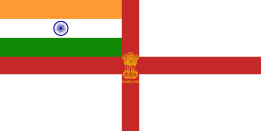List of frigates of India
This is a list of frigates of the Indian Navy, grouped by class, and ordered by pennant number within each class. A frigate (/ˈfrɪɡᵻt/) is any of several types of warship, the term having been used for ships of various sizes and roles over the last few centuries. Generally, frigates are considered as the vessels that are intermediate between corvettes and destroyers.[1]
Frigates have had a significant role in the naval history of India. Though the Maratha Navy, the naval branch of the armed forces of the Maratha Empire, used Grabs and Gallivats to project naval power,[2] the concept of frigates or sloops[lower-alpha 1] was introduced by the British. The Royal Indian Navy was expanded significantly during the Second World War.[3] HMIS Clive, HMIS Lawrence and HMIS Cornwallis of the Aubretia class, which served in World War II, were some of the early sloops commissioned into the Royal Indian Navy during the 1920s.[4][5][6]
Later, sloops of the Black Swan,[7][8] Grimsby,[9] P, Hastings, and Anchusa classes were commissioned.[10][11][12] The sloops HMIS Sutlej and HMIS Jumna of the Black Swan class took part in Operation Husky, the Allied invasion of Sicily.[13] In 1945, HMIS Dhanush and HMIS Shamsher of the River class were the first frigates, so-called, commissioned into the Royal Indian Navy. They were later transferred to Pakistan during partition.[14] Later, several frigates from the River class were commissioned.[15]
In the post-war period, the Indian Navy operated frigates from the Blackwood,[16] Whitby,[17] Leopard,[18] Leander,[19] and Nilgiri classes.[20] The Nilgiri-class frigates were the first major warships to be built in India, in association with Yarrow Shipbuilders of the United Kingdom.[20] Currently, 14 guided-missile frigates from four different classes – Shivalik, Talwar, Brahmaputra, and Godavari – are operated by the Indian Navy.[21][22]
Ships currently in commission
Fourteen frigates from four different classes are currently in active service with the Indian Navy.[21] The Shivalik class is the heaviest of the frigate classes presently serving with the Indian Navy.[23] INS Shivalik, which is named after the Shivalik hills, is the lead ship of the class and the first stealth warship built by India.[24] All three ships of this class were built by Mazagon Dock Limited, Mumbai, from 2000 to 2010. With their improved stealth features and land-attack capabilities, the Shivalik-class warships were originally conceived as successors to the six Talwar-class frigates,[23] which are modified Krivak III-class vessels built by Russia for the Indian Navy.[25] The Talwar class was preceded by the Brahmaputra-class frigates, which were built by the Garden Reach Shipbuilders and Engineers, Kolkata. Three ships of this class are still in service with the Indian Navy.[26] The predecessors to the Brahmaputra class were the three Godavari-class frigates, with two still in service, the lead ship, INS Godavari, having been decommissioned in 2015.[27]
Shivalik class
The Shivalik class, or Project 17 class, is a class of multi-role frigates in service with the Indian Navy. They are the first stealth warships built in India.[28] A total of three ships were built between 2000 and 2010, and all three were in commission by 2012.[23] The Shivalik class, along with the seven Project 17A frigates currently being developed from them, are projected to be the principal frigates of the Indian Navy in the first half of the 21st century.[29] All ships of the class were built by Mazagon Dock Limited. The lead vessel, and thus the class, is named after the Shivalik hills, and the subsequent vessels in the class are also named after hill ranges in India.[23] Originally conceived as a successor to the Talwar-class frigates, the Shivalik-class frigates feature improved stealth features and land-attack capabilities.[23]
Ship |
Picture |
Armament |
Displacement |
Service |
Origin | |
|---|---|---|---|---|---|---|
Laid down |
Commissioned | |||||
| INS Shivalik (F47)[30] | 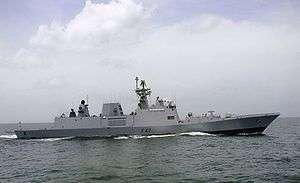 |
|
6,200 tonnes (6,100 long tons; 6,800 short tons) full load[31] | 11 July 2001 | 29 April 2010 | |
| INS Satpura (F48)[32] | .jpg) |
31 October 2002 | 20 August 2011 | |||
| INS Sahyadri (F49)[33] | _maneuvers_along_with_the_guided-missile_destroyer_USS_Chung-Hoon_(DDG_93)_while_conducting_a_search-and-rescue_exercise_during_Exercise_Malabar_2016.jpg) |
17 March 2003 | 21 July 2012 | |||
Talwar class
The Talwar class, also known as Project 1135.6, is a class of guided missile frigates designed and built by Russia for the Indian Navy, as modified Krivak III-class frigates[34] (the class that is also the basis of the Russian Admiral Grigorovich-class frigate), with a number of systems of Indian design and manufacture, including anti-submarine sensors (sonar) and communications equipment.[35][36][37] Each ship of this class has a displacement of 4,000 tons and speed of 30 knots (56 km/h; 35 mph) and is capable of accomplishing a wide variety of missions, primarily finding and eliminating enemy submarines and large surface ships. Due to the use of stealth technologies and a special hull design, the frigate operates with reduced radar cross section (RCS), as well as reduced electromagnetic, acoustic, and infrared signatures.[35]
Ship |
Picture |
Armament |
Displacement |
Service |
Origin | |
|---|---|---|---|---|---|---|
Laid down |
Commissioned | |||||
| INS Talwar (F40)[38] | 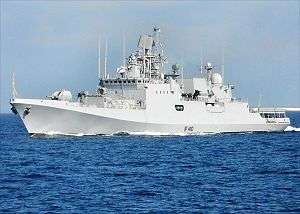 |
4,035 tonnes (3,971 long tons; 4,448 short tons)[39] | 10 March 1999 | 18 June 2003 | ||
| INS Trishul (F43)[41] |  |
24 September 1999 | 24 November 2000 | |||
| INS Tabar (F44) |  |
26 May 2000 | 25 May 2001 | |||
| INS Teg (F45)[42] | July 2007 | 27 April 2012 | ||||
| INS Tarkash (F50)[43] |  |
9 November 2012 | ||||
| INS Trikand (F51)[44] | -image08.jpg) |
11 June 2008 | 29 June 2013 | |||
Brahmaputra class
The Brahmaputra-class frigates (Type 16A or Project 16A) are guided-missile frigates of the Indian Navy, designed and built in India. They are an enhancement of the Godavari class, with the same displacement, 3850 tons, and length, 126 metres (413 ft), but with different configuration, armaments, and capabilities. Three ships of this class serve in the Indian Navy. The class and the lead ship, INS Brahmaputra, are named after the River Brahmaputra. Subsequent ships of the class, INS Betwa and INS Beas, are also named for Indian rivers.[26][45]
Ship |
Picture |
Armament |
Displacement |
Commissioned |
Origin |
|---|---|---|---|---|---|
| INS Brahmaputra (F31) |  |
3,850 tonnes (3,790 long tons; 4,240 short tons) | 14 April 2000 | ||
| INS Betwa (F39) |  |
7 July 2004 | |||
| INS Beas (F37) | 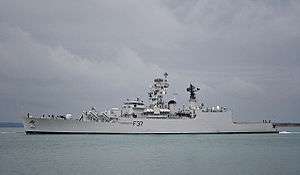 |
11 July 2005 |
Godavari class
The Godavari-class frigates (formerly Type 16 or Project 16 frigates) are guided-missile frigates of the Indian Navy. The Godavari class was the first significant indigenous warship design-and-development initiative of the Indian Navy. The design is a modification of the Nilgiri class, with larger hull and updated armaments, as well as with a focus on an indigenous content of 72%. Two ships of this class currently serve in the Indian Navy. The lead ship, INS Godavari, and the class, are named after the Godavari River. The subsequent ships in the class, INS Ganga and INS Gomati, also take their names from the Indian rivers. INS Gomati was the first Indian Navy vessel to employ digital electronics in her combat data system. The ships combine Indian, Russian, and Western weapons systems.[27][46][47]
Ship |
Picture |
Armament |
Displacement |
Commissioned |
Origin |
|---|---|---|---|---|---|
| INS Ganga (F22) | .jpg) |
|
3,850 tonnes (3,790 long tons; 4,240 short tons) | 30 December 1985 | |
| INS Gomati (F21) | 16 April 1988 |
Decommissioned ships
Most of the decommissioned frigates or sloops of the Indian Navy originated in the United Kingdom.
Sloops
A modern British sloop-of-war is a warship used for convoy defence. HMIS Clive,[4] HMIS Lawrence[4][5] and HMIS Cornwallis,[6] of the Aubretia class which served in World War II, were some of the early sloops commissioned into the Royal Indian Navy during the 1920s. These ships were also the first ships to be decommissioned. Later, sloops from the Black Swan,[7][8] Grimsby,[9] P, Hastings, and Anchusa classes were commissioned. The sloops HMIS Narbada[48] and HMIS Godaveri,[49] of the Black Swan class, and HMIS Hindustan,[50] of the Hastings class, were transferred to Pakistan post-partition. HMIS Elphinstone, of the Anchusa class, and HMIS Indus,[51] of the Grimsby class, were lost in action during the Second World War. The other sloops were subsequently scrapped after their decommissioning.[13]
Anchusa class
The twenty-eight Anchusa-class sloops were a small class of corvettes or convoy sloops built in 1917 and 1918 under the Emergency War Programme for the Royal Navy in World War I, as the final part of the larger "Flower class" (which were also referred to as the "cabbage class", or "herbaceous borders"). The sloops were single-screw with triple hulls at the bows to give extra protection against loss when working as fleet sweeping vessels, or as convoy protection ships (the class was built to look like merchant ships for use as Q-ships). HMS Ceanothus (1917) (later renamed as HMS Elphinstone), transferred to the Royal Indian Marine in 1922, was the only Anchusa-class sloop used by India.[52]
Ship |
Armament |
Displacement |
Service |
Origin |
Fate | ||
|---|---|---|---|---|---|---|---|
Commissioned (Royal Navy) |
Commissioned (Royal Indian Marine) |
Decommissioned | |||||
| HMIS Elphinstone |
|
1,290 tonnes (1,270 long tons; 1,420 short tons) | 2 June 1917 | May 1922 | Wrecked on the Nicobar Islands on 29 January 1925.[52] | ||
P class
The P class, nominally classified as "patrol boats", was in effect a class of coastal sloops. Twenty-four ships to this design were ordered in May 1915 (numbered P.11 to P.34), and another thirty between February and June 1916 (numbered P.35 to P.64), under the Emergency War Programme[53] for the Royal Navy in the First World War. In December 1916, ten of the latter group were altered on the stocks before launch for use as decoy Q-ships and were renumbered as PC-class sloops. Although usually not named, in 1925 P.38 was given the name Spey,[10] as well as HMIS Baluchi and HMIS Pathan, the two P-class sloops used by the Royal Indian Navy.[54]
Ship |
Armament |
Displacement |
Service |
Origin |
Fate | ||
|---|---|---|---|---|---|---|---|
Commissioned (Royal Navy) |
Commissioned (Royal Indian Navy) |
Decommissioned | |||||
| HMIS Baluchi (PC.55) |
|
613 tonnes (603 long tons; 676 short tons) | 5 May 1917 | May 1922 | 1935 | Sold for scrapping.[53] | |
| HMIS Pathan (PC.69) | 11 March 1918 | 5 August 1921 | Sunk by Italian submarine Galvani on 23 June 1940.[54] | ||||
Grimsby class
The Grimsby class was a class of 13 sloops-of-war laid down between 1933 and 1940. Eight were built in the United Kingdom for the Royal Navy, four in Australia for the Royal Australian Navy, and one, HMIS Indus, for the Royal Indian Navy.[51] The main armament was initially two 4.7-inch (119 mm) guns, for RN ships, or three 4-inch (102 mm), for Australian ships, although the armament varied considerably between ships and was increased later.[9]
Ship |
Picture |
Armament |
Displacement |
Service |
Origin |
Fate | ||
|---|---|---|---|---|---|---|---|---|
Laid down |
Commissioned (Royal Indian Navy) |
Decommissioned | ||||||
| HMIS Indus (U67) | 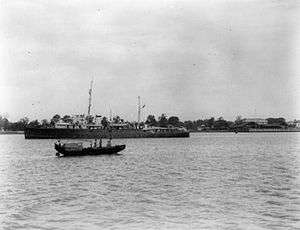 |
|
1,006 tonnes (990 long tons; 1,109 short tons) | 8 December 1933[55] | 15 March 1935[55] | Bombed and sunk by Japanese aircraft during the Burma Campaign on 6 April 1942.[51] | ||
Aubretia class
The Aubretia class was a class of twelve sloops built under the Emergency War Programme for the Royal Navy in World War I as part of the larger "Flower" class (also referred to as the "cabbage class", or "herbaceous borders"). The Flowers were the first ships designed as minesweepers. Like all the Flowers, the Aubretia class were originally designed as single-screw fleet sweeping vessels, with triple hulls at the bows and an above-water magazine located aft, to give extra protection against loss from mine damage when working. However, the greatest utility was to be as a convoy escort; and, as such, other classes took over the minesweeping role. The Aubretias were re-classified as convoy sloops.[10][52] HMIS Cornwallis of this class was used by the Royal Indian Navy from 1921 to 1946, when it was decommissioned.[6]
Ship |
Armament |
Displacement |
Service |
Origin |
Fate | ||
|---|---|---|---|---|---|---|---|
Commissioned (Royal Navy) |
Commissioned (Royal Indian Marine) |
Decommissioned | |||||
| HMIS Cornwallis (U09)[lower-alpha 2] |
|
1,250 tonnes (1,230 long tons; 1,380 short tons) | 21 August 1917 | September 1921 | 1946 | scrapped[6] | |
Black Swan class
The Black Swan and Modified Black Swan were two classes of sloops of the Royal Navy and Royal Indian Navy. Twelve Black Swans were launched between 1939 and 1943, including four for the Royal Indian Navy. Twenty-five Modified Black Swans were launched between 1942 and 1945, including two for the Royal Indian Navy. Several other ships were cancelled.[7][8] HMIS Jumna, commissioned in May 1941, was the first of the six vessels of this class, all named after rivers of India, commissioned into the Royal Indian Navy.[56]
Ship |
Armament |
Displacement |
Service |
Origin |
Fate | ||
|---|---|---|---|---|---|---|---|
| Laid down | Commissioned (Royal Indian Navy) |
Decommissioned | |||||
| HMIS Cauvery[lower-alpha 3] |
|
1,350 tonnes (1,330 long tons; 1,490 short tons)[lower-alpha 4] | 28 October 1942 | 26 August 1943 | 1977 | scrapped[57][58] | |
| HMIS Jumna[lower-alpha 5] | 20 February 1940 | 13 May 1941 | unknown | scrapped[56] | |||
| HMIS Narbada | 30 August 1941 | 29 April 1943 | 1948 | Transferred to Pakistan post-partition and served as PNS Jhelum.[48] | |||
| HMIS Kistna[lower-alpha 6] | 14 July 1942 | 26 August 1943 | 1981 | scrapped[59] | |||
| HMIS Godaveri | 30 August 1941 | 28 June 1943 | 1948 | Transferred to Pakistan post-partition and served as PNS Sind.[49] | |||
| HMIS Sutlej[lower-alpha 7] | 4 January 1940 | 23 April 1941 | 1978 | scrapped[60] | |||
Hastings class
The Hastings class, also known as Folkestone class, was a class of five sloops built for the Royal Navy and the Royal Indian Navy in the interwar period, which went on to see service in the Second World War.[11] HMIS Hindustan of this class served in the Royal Indian Navy.[61]
Ship |
Picture |
Armament |
Displacement |
Service |
Origin |
Fate | ||
|---|---|---|---|---|---|---|---|---|
| Laid down | Commissioned (Royal Indian Navy) |
Decommissioned | ||||||
| HMIS Hindustan (L80) | .jpg) |
|
1,210 tonnes (1,190 long tons; 1,330 short tons) | 4 September 1929 | 10 October 1930 | 1948 | Transferred to Pakistan post-partition and served as PNS Karsaz till 1960.[50] | |
Other sloops
Ship |
Armament |
Displacement |
Service |
Origin |
Fate | |
|---|---|---|---|---|---|---|
| Commissioned (Royal Indian Marine) | Decommissioned | |||||
| HMIS Clive (U79}[lower-alpha 8] |
|
2,083 tonnes (2,050 long tons; 2,296 short tons) | 20 April 1920 | 1947 | scrapped[4][62] | |
| HMIS Lawrence (U83)[lower-alpha 9] | 1,245 tonnes (1,225 long tons; 1,372 short tons) | 27 December 1919 | scrapped[5] | |||
Frigates
In 1945, HMIS Dhanush[14] and HMIS Shamsher[15] of the River class were the first frigates commissioned into the Royal Indian Navy. They were later transferred to Pakistan during partition.[14][15] Later, several more frigates of the River class were commissioned. Frigates of the Blackwood,[8] Whitby, Leopard, Nilgiri,[63] Leander, and Godavari classes served with the Indian Navy. Of these, the Nilgiri-class frigates, commissioned between 1972 and 1981, were the first home-grown frigates in Indian service. The last ship of the Nilgiri class, INS Taragiri, was decommissioned in 2013.[64] The two Godavari class frigates in service are scheduled to be decommissioned in the coming years.[47]
River class
The River class was a class of 151 frigates launched between 1941 and 1944 for use as anti-submarine convoy escorts in the North Atlantic. The majority served with the Royal Navy (RN) and Royal Canadian Navy (RCN), with some serving in other Allied navies: the Royal Australian Navy (RAN), the Free French Navy (FFN), the Royal Netherlands Navy and, post-war, the South African Navy (SAN).[12][65] Eight ships of this class served in the Royal Indian Navy.[65]
Ship |
Armament |
Displacement |
Service |
Origin |
Fate | ||
|---|---|---|---|---|---|---|---|
| Commissioned (Royal Navy) |
Commissioned (Royal Indian Navy) |
Decommissioned | |||||
| HMIS Neza (K239)[lower-alpha 10] |
|
1,390 tonnes (1,370 long tons; 1,530 short tons) | 7 May 1943 | 1946 | 1947 | Returned to the Royal Navy in April 1947. Scrapped in 1955.[66] | |
| HMIS Kukri (K243)[lower-alpha 11] | 27 February 1943 | 1946 | 1951 | Converted to survey vessel and recommissioned as INS Investigator post republic.[67] | |||
| HMIS Tir (K256)[lower-alpha 12] | 7 May 1943 | 3 December 1945 | 30 September 1977 | scrapped[68] | |||
| HMIS Tamar (K262)[lower-alpha 13] | 28 July 1943 | 1946 | December 1946 | Constructive total Loss after running aground off Hainan Island.[69] | |||
| HMIS Dhanush (K265)[lower-alpha 14] | 2 March 1943 | 1945 | 1948 | Transferred to Pakistan and served as PNS Zulfiqar.[14] | |||
| HMIS Hooghly (K330)[lower-alpha 15] | 16 June 1943 | Purchased 1948 | unknown | scrapped[65] | |||
| HMIS Shamsher (K392)[lower-alpha 16] | 20 January 1944 | 1945 | 1947 | Transferred to Pakistan and served as PNS Shamsher. Scrapped in 1959.[15] | |||
| HMIS Bengal (K419)[lower-alpha 17] | 6 June 1944 | Purchased 1948 | unknown | scrapped[70] | |||
Blackwood class
The Type 14 Blackwood was a ship class of minimal "second-rate" anti-submarine warfare frigates. Built for the Royal Navy, to supplement the Type-12 class, during the 1950s at a time of increasing threat from the Soviet Union's submarine fleet, they served until the late 1970s. Twelve ships of this class served with the Royal Navy and a further three were built for the Indian Navy.[16]
Ship |
Armament |
Displacement |
Service |
Origin |
Fate | ||
|---|---|---|---|---|---|---|---|
| Laid down | Commissioned | Decommissioned | |||||
| INS Kirpan (F144) |
|
1,479 tonnes (1,456 long tons; 1,630 short tons) | 5 November 1956 | July 1959 | 1978 | Transferred to Indian Coast Guard in 1978.[71][72] | |
| INS Kuthar (F146) | 19 September 1957 | November 1959 | 1978 | Transferred to Indian Coast Guard in 1978.[71] | |||
| INS Khukri (F149) | 29 December 1955 | 16 July 1958 | Sunk in action on 9 December 1971 during 1971 Indo-Pakistani War.[71][73] | ||||
Whitby class
The Type 12 or Whitby class was a six-ship class of anti-submarine frigates of the British Royal Navy, which entered service late in the 1950s. They were designed in the early 1950s as first-rate ocean-going convoy escorts, in the light of experience gained during World War II. At the time, the Royal Navy were designing single-role escorts and the Whitbys were designed as fast convoy escorts capable of tackling high-speed submarines. However, this made the Whitbys more sophisticated and expensive to produce in large numbers in the event of a major war, and so the Type 14 "utility" or "second-rate" anti-submarine frigate was developed to supplement the Type 12. Although themselves rapidly outdated, the Type 12 proved to be an excellent basis for a series of frigate designs used by the British and Commonwealth navies for the next 20 years.[17] Two ships from this class served in the Indian Navy.[74]
Ship |
Armament |
Displacement |
Service |
Origin |
Fate | ||
|---|---|---|---|---|---|---|---|
| Laid down | Commissioned | Decommissioned | |||||
| INS Talwar (F140) |
|
2,185 tonnes (2,150 long tons; 2,409 short tons) | 7 June 1957 | 26 April 1959 | Broken up for scrap in 1992.[74] | ||
| INS Trishul (F143) | 19 February 1957 | 13 January 1960 | Broken up for scrap in 1996.[74] | ||||
Leopard class
The Type 41 or Leopard class was a class of anti-aircraft defence frigates built for the Royal Navy (4 ships) and Indian Navy (3 ships) in the 1950s.[75]
Ship |
Armament |
Displacement |
Service |
Origin |
Fate | ||
|---|---|---|---|---|---|---|---|
| Laid down | Commissioned | Decommissioned | |||||
| INS Brahmaputra[lower-alpha 18] |
|
2,337 tonnes (2,300 long tons; 2,576 short tons) | 20 October 1955 | 31 March 1958 | Broken up in 1986.[75] | ||
| INS Beas | 29 November 1956 | 24 May 1960 | Broken up in 1992.[75] | ||||
| INS Betwa | 29 May 1957 | 8 December 1960 | Broken up in 1988.[75] | ||||
Nilgiri class
The Nilgiri class are updated versions of the Leander class, designed and built for the Indian Navy by Mazagon Dock Limited in Mumbai. Six ships were built between 1972 and 1981. Vessels of the class formed the 14th Frigate Squadron. The lead ship, INS Nilgiri, was the first major warship to be built in India, in collaboration with Yarrow Shipbuilders of the United Kingdom. The lead ship and its class are named for the Nilgiri Hills. Subsequent ships in the class are also named for hill ranges of India.[63] With the entry into service of the Shivalik class, the Nilgiri class has been decommissioned by the navy, five ships having been decommissioned, with one having been sunk in an accident. INS Taragiri was the last ship of the class to be decommissioned, on 27 June 2013 in Mumbai, after serving 33 years in the navy.[64]
Ship |
Armament |
Displacement |
Service |
Origin |
Fate | |
|---|---|---|---|---|---|---|
| Commissioned | Decommissioned | |||||
| INS Nilgiri (F33) |
|
2,682 tonnes (2,640 long tons; 2,956 short tons) | 3 June 1972 | 1996 | Sunk on 24 April 1997, in a test firing of a Sea Eagle anti-ship missile by a Sea Harrier Frs Mk 51 taking off from the aircraft carrier, INS Viraat.[76] | |
| INS Himgiri (F34) | 23 November 1974 | 6 May 2005 | Awaiting disposal[76][77] | |||
| INS Udaygiri (F35) | 18 February 1976 | 24 August 2007 | Awaiting disposal[76] | |||
| INS Dunagiri (F36) | 5 May 1977 | 20 October 2010 | Awaiting disposal[76] | |||
| INS Taragiri (F41) | 16 May 1980 | 27 June 2013 | Awaiting disposal[76][64] | |||
| INS Vindhyagiri (F42) | 8 July 1981 | 11 June 2012 | Collided with a merchant ship while in Mumbai harbour on 30 January 2011; sank after on-board fire. Re-floated and decommissioned with full honours in 2012.[76][78] | |||
Leander class
The Leander-class, or Type 12I frigates, comprising twenty-six vessels, was among the most numerous and long-lived classes of frigates in the modern history of the Royal Navy. The class was built in three batches between 1959 and 1973. INS Krishna, formerly HMS Andromeda, from Batch 3A, served in the Indian Navy.[79]
Ship |
Picture |
Armament |
Displacement |
Service |
Origin |
Fate | |||
|---|---|---|---|---|---|---|---|---|---|
| Laid down | Commissioned (Royal Navy) |
Commissioned (Indian Navy) |
Decommissioned | ||||||
| INS Krishna (F46)[lower-alpha 19] | .jpg) |
|
2,500 tonnes (2,500 long tons; 2,800 short tons) | 25 May 1966 | 2 December 1968 | 22 August 1995 | 24 May 2012 | Awaiting disposal[80][81] | |
Godavari class
Ship |
Picture |
Armament |
Displacement |
Service |
Origin |
Fate | ||
|---|---|---|---|---|---|---|---|---|
| Laid down | Commissioned | Decommissioned | ||||||
| INS Godavari (F20) | 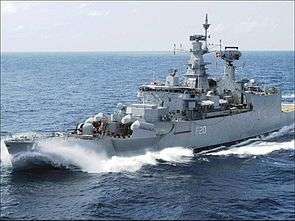 |
3,600 tonnes (3,500 long tons; 4,000 short tons) | 3 November 1978 | 10 December 1983 | 23 December 2015 | Awaiting disposal[82][83] | ||
Future ships
A total of ten ships from two different projects, Project 17A and Admiral Grigorovich classes, are expected to be commissioned into the Indian Navy. Most of these ships are in the planning phase.[84]
Project 17A class
The Project 17A-class frigate is a follow-on of the Project 17 Shivalik class frigate for the Indian Navy. A total of seven ships will be built at Mazagon Dock and GRSE. The first ship is expected to start construction by early 2017 and to be launched by 2020.[84]
No. of ships planned |
Picture |
Armament |
Displacement |
Status |
Origin |
|---|---|---|---|---|---|
| 7 | 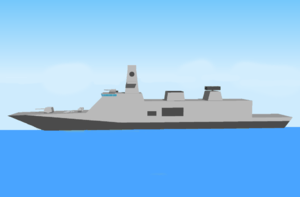 |
|
6,670 tonnes (6,560 long tons; 7,350 short tons) | Planning phase |
Admiral Grigorovich class
The Admiral Grigorovich class is a variant of the Russian-built Talwar class frigate currently in service with the Indian Navy. Six of this class were planned for service with the Russian Navy, with the engines to be supplied by the Ukrainian government-owned firm Zorya-Mashproekt. Of the first batch of three frigates, two vessels are currently in service with Russia, with the last to be commissioned in 2016. The 2014 Crimean crisis halted any further cooperation between the Russian and Ukrainian governments, leaving the second batch of three ships without engines. In August 2016, Russia agreed to sell the second batch of frigates to India. India will likely be able to acquire Ukrainian-built engines on its own. The frigates remain under construction, and it is possible the hulls could be transported to India for their final fitting-out, including the installation of their engines.[87]
No. of ships planned |
Picture |
Armament |
Displacement |
Status |
Origin |
|---|---|---|---|---|---|
| 4 |  |
tbd | 4,035 tonnes (3,971 long tons; 4,448 short tons) | Planning phase |
See also
- List of active Indian Navy ships
- Future of the Indian Navy
- List of ships of the Indian Navy
- List of submarines of the Indian Navy
- List of destroyers of the Indian Navy
Notes
Footnotes
- ↑ Earlier, frigates were called sloops, and only later were reclassified as frigates.
- ↑ Formerly HMS Lychnis (L09).
- ↑ Renamed as INS Kaveri post republic.
- ↑ Original: 1,250 tonnes (1,230 long tons; 1,380 short tons)
- ↑ Renamed as INS Jamuna post republic.
- ↑ Renamed as INS Krisna post republic.
- ↑ Renamed as INS Sutlej post republic.
- ↑ Previously L79.
- ↑ Previously L83.
- ↑ Formerly HMS Test.
- ↑ Formerly HMS Trent. Renamed INS Kukri post republic.
- ↑ Formerly HMS Bann. Renamed INS Tir post republic.
- ↑ Formerly HMS Aire.
- ↑ Formerly HMS Deveron.
- ↑ Formerly HMCS Waskesiu. Renamed INS Hooghly post republic.
- ↑ Formerly HMS Nadder.
- ↑ Formerly HMCS Kokanee. Renamed INS Bengal post republic.
- ↑ Formerly HMS Panther.
- ↑ Formerly HMS Andromeda.
Citations
- ↑ "Definition of FRIGATE". www.merriam-webster.com. Retrieved 14 July 2016.
- ↑ Sridharan 2000, p. 43.
- ↑ Bhatia 2008, p. 30.
- 1 2 3 "Modified Black Swan class Sloops – Allied Warships of WWII". uboat.net. Retrieved 15 July 2016.
- 1 2 3 4 "Black Swan class Sloops – Allied Warships of WWII". uboat.net. Retrieved 15 July 2016.
- 1 2 3 "Grimsby class Sloops – Allied Warships of WWII". uboat.net. Retrieved 15 July 2016.
- 1 2 "Steel Sloops". www.leander-project.homecall.co.uk. Retrieved 15 July 2016.
- 1 2 "WWII Frigates". www.leander-project.homecall.co.uk. Retrieved 11 July 2016.
- 1 2 The Second World War in the Mediterranean, North Africa and Italy at the Wayback Machine (archived January 24, 2008)
- 1 2 Friedman 2008, p. 14.
- 1 2 Friedman 2008, pp. 214–216.
- ↑ Friedman 2008, p. 202.
- ↑ Friedman 2008, p. 13.
- 1 2 Lt Cdr Kalesh Mohanan (14 December 2012). "Indigenous Warship Building". Indian Defence Review. Retrieved 15 July 2016.
- 1 2 3 4 5 6 "Shivalik Class Frigates". Naval Technology. Retrieved 11 July 2016.
- ↑ "Riding the waves". www.rediff.com. Retrieved 11 July 2016.
- 1 2 "Talwar Class / Project 11356". www.globalsecurity.org. Retrieved 11 July 2016.
- ↑ "Riding the waves". Rediff.com. 10 May 2003. Retrieved 1 May 2013.
- ↑ "Capital Cruisers", Sainik Samachar, Ministry of Defence (India), 15 March 2004. Adm. Madhvendra Singh, Chief of Naval Staff: "These would be the future ships of the Indian Navy and will be of the Shivalik class".
- ↑ "INS Sahyadri Commissioning July 21". Defence Now. Retrieved 11 July 2016.
- ↑ "Mikhailov: the contract on 3 frigates for India to be executed in 2012". rusnavy.com. Retrieved 23 August 2016.
- ↑ "India to acquire three Admiral Grigorovich-class frigates from Russia | IHS Jane's 360". www.janes.com. Retrieved 23 August 2016.
- ↑ "India, Russia likely to sign deal for 4 stealth frigates". The Hindu. 22 December 2015. Retrieved 23 August 2016.
- ↑ "The 3rd ship for the Indian Navy was carried out by JSC Shipyard "Yantar"". Shipyard-yantar.ru. Retrieved 2011-02-01.
- ↑ Vladimir Radyuhin. "INS Trishul launched in Russian waters". www.thehindu.com. Retrieved 11 July 2016.
- ↑ Rajat Pandit (29 June 2013). "India inducts new power-packed stealth frigate INS Trikand – Times of India". Times of India. Retrieved 11 July 2016.
- 1 2 "P-16A Class / Brahmaputra Class Frigates". Naval Technology. Retrieved 11 July 2016.
- ↑ "Godavari (Type 16) Class". Bharat-Rakshak.com. Retrieved 26 September 2014.
- 1 2 3 "F 20 Godavari Class". www.globalsecurity.org. Retrieved 11 July 2016.
- 1 2 "Indian sloop HMIS Narbada". www.naval-history.net. Retrieved 11 July 2016.
- 1 2 3 "British, RN Sloops and Escorts of WW1". www.naval-history.net. Retrieved 23 August 2016.
- 1 2 "P boats of the First World War". TW Museums. Retrieved 23 August 2016.
- 1 2 Hague 1993, p. 60.
- ↑ "Indian sloop HMIS Cauvery". www.naval-history.net. Retrieved 11 July 2016.
- ↑ "Indian sloop HMIS Kistna". www.naval-history.net. Retrieved 11 July 2016.
- ↑ "Indian sloop HMIS Sutlej". www.naval-history.net. Retrieved 11 July 2016.
- ↑ "Folkestone class Sloops – Allied Warships of WWII – uboat.net". uboat.net. Retrieved 23 August 2016.
- ↑ "Eastern Fleet War Diary 1943". www.naval-history.net. Retrieved 11 July 2016.
- 1 2 "F 33 Nilgiri Class". www.globalsecurity.org. Retrieved 11 July 2016.
- 1 2 3 "INS Taragiri bows out of service". Business Standard. 27 June 2013. Retrieved 11 July 2016.
- 1 2 3 "RIVER Class". www.hazegray.org. Retrieved 11 July 2016.
- 1 2 3 Conway 1995, p. 173.
- ↑ "Screw Steamer PHOEBE built by Abercorn Shipbuilding Co in 1876 for Pile & Co [J. C. Briggs] London, Cargo". www.clydeships.co.uk. Retrieved 11 July 2016.
- ↑ "The Indo-Pakistan Wars – the maritime point of view". Weapons and Warfare. 23 February 2016. Retrieved 11 July 2016.
- 1 2 3 Singh 1992, p. 85.
- 1 2 3 4 Conway 1995, p. 174.
- 1 2 3 4 5 6 Hiranandani 2000, p. 81–92.
- ↑ "INS Himgiri decommissioned". Zee News. 5 May 2005. Retrieved 11 July 2016.
- ↑ Leander Class General Purpose Frigate (Type 12 Improved) at the Wayback Machine (archived December 12, 2006)
- ↑ "India's first indigenously designed & built frigate INS Godavari to be decommissioned". Economic Times. Retrieved 11 July 2016.
- 1 2 Sengupta, Prasan K. (September 2012). "CCNS finally kickstarts Indian Navy's Project 17A". ForceIndia.com. Retrieved 21 February 2015.
- ↑ "MoD gives nod to 7 stealth frigates worth Rs 13,000 crore – Times of India". Times of India. 12 May 2016. Retrieved 11 July 2016.
- 1 2 "India to acquire three Admiral Grigorovich-class frigates from Russia". IHS Jane's Defence Weekly. 4 August 2016. Retrieved 5 August 2016.
References
- Bhatia, HS (2008), Military History of British India, 1607–1947 (2nd ed.), New Delhi: Deep & Deep Publications, ISBN 978-81-8450-079-0
- Colledge, James Joseph (2006), Ships of the Royal Navy: The Complete Record of all Fighting Ships of the Royal Navy, London: Chatham Publishing, ISBN 978-1-86176-281-8
- Conway, Robert (1995), All the World's Fighting Ships 1947–1995, Conway Maritime Press, ISBN 0-85177-605-1
- Friedman, Norman (2008), British Destroyers & Frigates: The Second World War and After (reprint ed.), Barnsley: Seaforth, ISBN 978-1-84832-015-4
- Hague, Arnold (1993). Sloops: A History of the 71 Sloops Built in Britain and Australia for the British, Australian and Indian Navies 1926–1946. Kendal, England: World Ship Society. ISBN 0-905617-67-3.
- Hiranandani, GM (2000), Transition to Triumph: History of the Indian Navy, 1965–1975, Lancer Publishers, ISBN 978-1-897829-72-1
- Singh, Satyindra (1992), Blueprint to Bluewater: The Indian Navy, 1951–65, New Delhi: Lancer International, ISBN 978-81-7062-148-5
- Sridharan, K (2000), Sea: Our Saviour, New Delhi: Taylor & Francis, ISBN 978-81-224-1245-1
